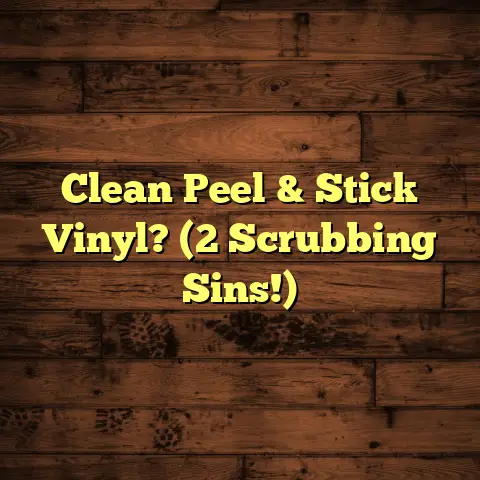Removing Ceramic Tile Adhesive? (5-Min Hack!)
Ever ripped up old ceramic tiles, feeling
victorious, only to be confronted with that
rock-hard, seemingly impossible-to-remove
adhesive?
I’ve been there, trust me.
It’s like the tile adhesive is mocking you, right?
I’ve spent countless hours on my knees,
sweating and scraping, fighting the good
fight against this tenacious foe.
But what
if I told you there’s a faster, easier way?
A way to reclaim your weekend and your sanity?
That’s right, I am talking about a 5-minute hack that’ll have you saying, “Adhesive, be gone!” Let’s dive in and get that subfloor smooth and ready for your new flooring!
Section 1: Understanding Ceramic Tile Adhesive
So, what exactly is this stuff we’re battling?
Ceramic tile adhesive, in its simplest form,
is a bonding agent used to secure ceramic
tiles to a subfloor or wall.
It’s the glue
that holds your beautiful tile patterns in
place.
Think of it as the unsung hero (or villain, depending on your current predicament) of any tile installation.
There’s a whole family of these adhesives, each with its own strengths and weaknesses:
Thin-set Mortar: This is the workhorse of the tile world.
Made from cement, fine sand, and water-retentive additives, it’s incredibly strong and durable, perfect for high-traffic areas and wet environments.Mastic: This is an organic-based adhesive that used to be popular, but has fallen out of favor.
It’s easier to spread than thin-set, but less resistant to moisture.
I generally advise against using mastic these days.Epoxy Mortar: This is the heavy-duty option.
It’s a two-part system that, when mixed, creates a super-strong, chemical-resistant bond.
It’s the go-to choice for industrial applications and areas exposed to harsh chemicals.
Why do we even need to remove this stuff?
Well, maybe you’re renovating and want a fresh start with new tiles or a completely different flooring type.
Or perhaps you’re dealing with a cracked tile and need to replace it, which means tackling the surrounding adhesive.
Sometimes, it’s simply a matter of prepping the subfloor for a new installation, and that old adhesive is standing in the way.
Whatever the reason, removing tile adhesive is often a necessary evil in the world of home improvement.
Section 2: Common Challenges in Removing
Tile Adhesive
Okay, let’s be real.
Removing tile adhesive
is rarely a walk in the park.
It’s more like
a marathon through a sticky, dusty obstacle
course.
Here are some of the common challenges I’ve encountered (and I’m sure you have too):
Stubborn Residue: This is the most common culprit.
The adhesive just won’t budge, leaving behind a thin, tenacious layer that seems permanently bonded to the subfloor.-
Damage to the Subfloor: In our eagerness to remove the adhesive, we can sometimes get a little too enthusiastic with the scraper, gouging and damaging the subfloor in the process.
Time Consumption: Let’s face it, nobody wants to spend their entire weekend scraping away at tile adhesive.
It’s a tedious, time- consuming task that can quickly drain your energy and motivation.
I remember one time, I was helping a friend
renovate his kitchen.
We ripped up the old
ceramic tiles, expecting a smooth, easy
transition to the new flooring.
Boy, were we wrong. The adhesive was like concrete, stubbornly clinging to the subfloor.
We spent hours hacking away at it with
scrapers and chisels, making little to no
progress.
It was a frustrating experience
that nearly derailed the entire project.
That’s when I started searching for a better way.
A faster, easier, and less back-breaking way
to remove tile adhesive.
And that’s how I stumbled upon the 5-minute hack.
Section 3: The 5-Min Hack Explained
Alright, time for the main event!
This is
where I show you the magic trick that will
transform you from a frustrated scraper into
a tile adhesive-removal ninja.
This trick has saved me hours on the job.
Now, before you start picturing some high- tech gadget or complicated chemical concoction, let me assure you: this hack is surprisingly simple and uses readily available tools and materials.
Here’s what you’ll need:
Heat Gun: This is the star of the show.
A heat gun directs a concentrated stream of hot air onto the adhesive, softening it and making it easier to remove.Putty Knife or Scraper: You’ll need a sturdy putty knife or scraper to lift and remove the softened adhesive.
I recommend one with a comfortable handle and a sharp blade.-
Vinegar: Plain old white vinegar acts as a natural solvent, helping to further break down the adhesive.
-
Water: Water is used to dilute the vinegar and clean the surface after removing the adhesive.
-
Spray Bottle: A spray bottle makes it easy to apply the vinegar and water mixture to the affected area.
Now, let’s get down to business. Here’s the step-by-step guide to the 5-minute hack:
Prep the Area: Make sure the area is well-ventilated.
Open windows and doors to allow for proper airflow.Heat It Up: Turn on your heat gun and hold it a few inches away from the adhesive.
Move the heat gun back and forth in a slow, sweeping motion, focusing on a small area at a time.
Imagine the heat gun slowly melting a pat of butter.Scrape Away: As the adhesive softens, use your putty knife or scraper to lift and remove it.
Apply firm, even pressure and work your way under the adhesive, peeling it away from the subfloor.
Picture yourself lifting a corner of wallpaper and gently peeling it off the wall.Vinegar Power: In a spray bottle, mix equal parts vinegar and water.
Spray the mixture onto any remaining adhesive residue.
Let it sit for a minute or two to allow the vinegar to work its magic.
Visualize the vinegar dissolving the stubborn adhesive like a gentle acid.Final Scrape: Use your putty knife or scraper to remove any remaining residue.
Wipe the surface clean with a damp cloth.
Think of this as the final polish, leaving the subfloor smooth and ready for its next chapter.
Visual Aid (Imagined):
Image 1: A hand holding a heat gun, directing it towards a patch of ceramic tile adhesive on a subfloor.
Heat waves are visually represented emanating from the heat gun.Image 2: A hand using a putty knife to scrape away softened adhesive from the subfloor.
The adhesive is peeling away easily.-
Image 3: A spray bottle spraying a mixture of vinegar and water onto the subfloor.
-
Image 4: A clean subfloor, free of adhesive residue.
Important Note: Always wear safety glasses and gloves when working with a heat gun and chemicals.
Section 4: Alternative Methods for Removing
Adhesive
While the 5-minute hack is my go-to method,
it’s not always the perfect solution for
every situation.
Sometimes, you need to
bring in the big guns.
Here are some alternative methods for removing ceramic tile adhesive:
Chemical Removers and Solvents: These products are designed to dissolve adhesive, making it easier to remove.
They can be effective, but they also come with some drawbacks.-
Effectiveness: Chemical removers can be very effective at dissolving stubborn adhesive, especially if it’s a type that doesn’t respond well to heat.
-
Safety Precautions: Always wear gloves, eye protection, and a respirator when working with chemical removers.
Make sure the area is well-ventilated.
-
Mechanical Methods: These methods involve using tools to physically remove the adhesive.
-
Scrapers and Chisels: These are the classic tools for removing tile adhesive.
They’re inexpensive and readily available, but they can be time-consuming and require a lot of elbow grease. -
Floor Buffers: These machines are designed to sand and polish floors.
With the right attachment, they can also be used to remove tile adhesive.
They’re faster than hand scraping, but they can also be more aggressive and potentially damage the subfloor.
-
When to Use Alternative Methods:
-
Large Areas: If you’re dealing with a large area of adhesive, a floor buffer might be a better option than the 5-minute hack.
-
Heat-Sensitive Materials: If your subfloor is made of a material that could be damaged by heat, such as vinyl or linoleum, you’ll want to avoid using a heat gun.
Tough Adhesive: Some types of adhesive, like epoxy mortar, are incredibly strong and resistant to heat.
In these cases, a chemical remover might be your best bet.
Section 5: Cleaning Up After Adhesive Removal
Congratulations!
You’ve successfully removed
the bulk of the tile adhesive.
But the job
isn’t quite finished yet.
Cleaning up after adhesive removal is crucial for ensuring a smooth and successful new flooring installation.
Here’s how to do it:
-
Vacuum: Start by vacuuming the entire area to remove any loose debris, dust, and adhesive fragments.
Wash: Wash the subfloor with a mild detergent and water.
Use a scrub brush to remove any remaining residue.-
Rinse: Rinse the subfloor thoroughly with clean water to remove any traces of detergent.
Dry: Allow the subfloor to dry completely before proceeding with the new flooring installation.
You can speed up the drying process by using fans or a dehumidifier.Inspect: Once the subfloor is dry, carefully inspect it for any remaining adhesive residue or damage.
If you find any, repeat the cleaning process or repair the damage as needed.
Why is this step so important?
Because any remaining adhesive residue can
interfere with the bonding of your new flooring.
It can also create an uneven surface, leading
to problems down the road.
A clean, smooth subfloor is the foundation for
a successful flooring installation.
Don’t skip
this step!
Section 6: Final Touches and Preparation for
New Flooring
You’ve conquered the adhesive, cleaned the
subfloor, and now you’re ready to lay down
your new flooring.
But before you start
unrolling that carpet or clicking those
laminate planks into place, there are a few
final touches to consider.
Here’s a checklist of tasks to complete before installing your new flooring:
Moisture Testing: Moisture is the enemy of many flooring types.
Before installing any new flooring, it’s essential to test the moisture content of the subfloor.-
You can use a moisture meter to measure the moisture content directly.
-
If the moisture content is too high, you’ll need to take steps to dry out the subfloor before proceeding.
-
-
Leveling the Surface: An uneven subfloor can cause problems with your new flooring, such as warping, cracking, or uneven wear.
-
Use a level to check for any dips or high spots in the subfloor.
-
If you find any, you’ll need to level the surface using a self-leveling compound or a patching compound.
-
-
Underlayment: Depending on the type of flooring you’re installing, you may need to install an underlayment.
-
Underlayment provides cushioning, sound insulation, and moisture protection.
-
Choose an underlayment that is specifically designed for your flooring type.
-
By taking these final steps, you’ll ensure that your new flooring looks great and lasts for years to come.
Conclusion: Recap of the 5-Min Hack
There you have it!
The 5-minute hack for
removing ceramic tile adhesive.
A simple,
effective, and time-saving solution that
will make your flooring projects a whole lot
easier.
Let’s recap the key points:
- Use a heat gun to soften the adhesive.
- Scrape away the softened adhesive with a putty knife or scraper.
- Spray any remaining residue with a mixture of vinegar and water.
- Clean the subfloor thoroughly and prepare it for the new flooring installation.
I hope this article has been helpful and
informative.
Now, go forth and conquer that
stubborn tile adhesive!
I’d love to hear about your experiences with
the 5-minute hack.
Share your results and
any tips or tricks you’ve discovered in the
comments below.
Let’s build a community of DIY warriors who are armed with the knowledge and tools to tackle any flooring challenge!





